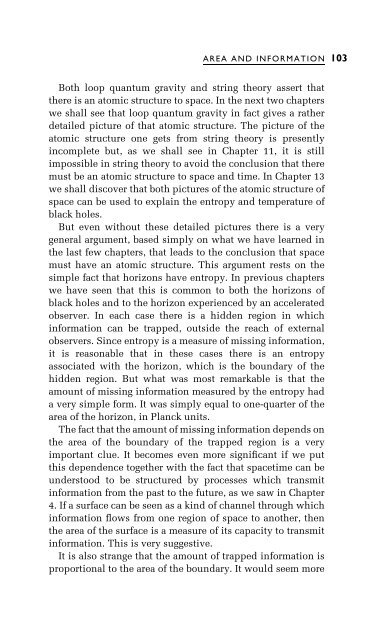Three Roads To Quantum Gravity
Three Roads To Quantum Gravity
Three Roads To Quantum Gravity
Create successful ePaper yourself
Turn your PDF publications into a flip-book with our unique Google optimized e-Paper software.
AREA AND INFORMATION<br />
103<br />
Both loop quantum gravity and string theory assert that<br />
there is an atomic structure to space. In the next two chapters<br />
we shall see that loop quantum gravity in fact gives a rather<br />
detailed picture of that atomic structure. The picture of the<br />
atomic structure one gets from string theory is presently<br />
incomplete but, as we shall see in Chapter 11, it is still<br />
impossible in string theory to avoid the conclusion that there<br />
must be an atomic structure to space and time. In Chapter 13<br />
we shall discover that both pictures of the atomic structure of<br />
space can be used to explain the entropy and temperature of<br />
black holes.<br />
But even without these detailed pictures there is a very<br />
general argument, based simply on what we have learned in<br />
the last few chapters, that leads to the conclusion that space<br />
must have an atomic structure. This argument rests on the<br />
simple fact that horizons have entropy. In previous chapters<br />
we have seen that this is common to both the horizons of<br />
black holes and to the horizon experienced by an accelerated<br />
observer. In each case there is a hidden region in which<br />
information can be trapped, outside the reach of external<br />
observers. Since entropy is a measure of missing information,<br />
it is reasonable that in these cases there is an entropy<br />
associated with the horizon, which is the boundary of the<br />
hidden region. But what was most remarkable is that the<br />
amount of missing information measured by the entropy had<br />
a very simple form. It was simply equal to one-quarter of the<br />
area of the horizon, in Planck units.<br />
The fact that the amount of missing information depends on<br />
the area of the boundary of the trapped region is a very<br />
important clue. It becomes even more signi®cant if we put<br />
this dependence together with the fact that spacetime can be<br />
understood to be structured by processes which transmit<br />
information from the past to the future, as we saw in Chapter<br />
4. If a surface can be seen as a kind of channel through which<br />
information ¯ows from one region of space to another, then<br />
the area of the surface is a measure of its capacity to transmit<br />
information. This is very suggestive.<br />
It is also strange that the amount of trapped information is<br />
proportional to the area of the boundary. It would seem more



![arXiv:1001.0993v1 [hep-ph] 6 Jan 2010](https://img.yumpu.com/51282177/1/190x245/arxiv10010993v1-hep-ph-6-jan-2010.jpg?quality=85)


![arXiv:1008.3907v2 [astro-ph.CO] 1 Nov 2011](https://img.yumpu.com/48909562/1/190x245/arxiv10083907v2-astro-phco-1-nov-2011.jpg?quality=85)








![arXiv:1002.4928v1 [gr-qc] 26 Feb 2010](https://img.yumpu.com/41209516/1/190x245/arxiv10024928v1-gr-qc-26-feb-2010.jpg?quality=85)
![arXiv:1206.2653v1 [astro-ph.CO] 12 Jun 2012](https://img.yumpu.com/39510078/1/190x245/arxiv12062653v1-astro-phco-12-jun-2012.jpg?quality=85)
